What We’re Reading: August 24th
Review: X-ray fluorescence microscopy imaging
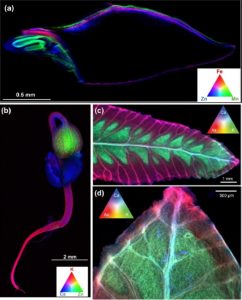 Kopittke et al. review the use of synchrotron-based X-ray fluorescence microscopy as a tool to quantify and localize diverse elements in plants. The authors describe how this method can be used to study nutrients in plants and human foods, as well as metal hyperaccumulating plants, and toxic metal(oid) accumulation. Future applications might include the use of metals as molecular tags as an imaging method, and imaging of nanoparticles. The authors also describe how advances in optics and electronics have improved the speed, sensitivity and resolution of X-ray fluorescence microscopy and hence the insights it can provide. They also observe that access to synchrotron facilities is a problem, and that currently, data collected is not routinely deposited into public databases. (Summary by Mary Williams) Plant Physiol: 10.1104/pp.18.00759
Kopittke et al. review the use of synchrotron-based X-ray fluorescence microscopy as a tool to quantify and localize diverse elements in plants. The authors describe how this method can be used to study nutrients in plants and human foods, as well as metal hyperaccumulating plants, and toxic metal(oid) accumulation. Future applications might include the use of metals as molecular tags as an imaging method, and imaging of nanoparticles. The authors also describe how advances in optics and electronics have improved the speed, sensitivity and resolution of X-ray fluorescence microscopy and hence the insights it can provide. They also observe that access to synchrotron facilities is a problem, and that currently, data collected is not routinely deposited into public databases. (Summary by Mary Williams) Plant Physiol: 10.1104/pp.18.00759
Review: What do cars and plants have in common?
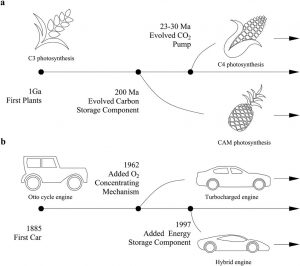 Plants and cars need energy and are powered by a process that has changed depending on the environment: photosynthesis, in the case of plants and an engine in the case of cars. Hartzell and coworkers make an analogy in the evolution of the original C3 pathway and the evolution of the internal combustion engine (ICE) of the first car. They compare the efficiency of varying CO2 concentration in the C4 cycle vs C3 cycle using data from soybean, wheat, corn and sorghum. For the engine comparison they use data from supercharged or turbocharged engines that work under low oxygen concentration and compare it with a conventional ICE. Both situations are considered an example of evolution of substrate concentration mechanism. CAM photosynthesis and HEV (hybrid electric vehicles) are considered examples of evolution of energy storage mechanism; both succeed under conditions where improved efficiency is advantageous: fuel for cars and water for plants. (Summary by Cecilia Vasquez-Robinet) PLOS One 10.1371/journal.pone.0198044
Plants and cars need energy and are powered by a process that has changed depending on the environment: photosynthesis, in the case of plants and an engine in the case of cars. Hartzell and coworkers make an analogy in the evolution of the original C3 pathway and the evolution of the internal combustion engine (ICE) of the first car. They compare the efficiency of varying CO2 concentration in the C4 cycle vs C3 cycle using data from soybean, wheat, corn and sorghum. For the engine comparison they use data from supercharged or turbocharged engines that work under low oxygen concentration and compare it with a conventional ICE. Both situations are considered an example of evolution of substrate concentration mechanism. CAM photosynthesis and HEV (hybrid electric vehicles) are considered examples of evolution of energy storage mechanism; both succeed under conditions where improved efficiency is advantageous: fuel for cars and water for plants. (Summary by Cecilia Vasquez-Robinet) PLOS One 10.1371/journal.pone.0198044
The transcriptional landscape of polyploid wheat ($)
 Wheat is a tough nut to crack, as it is hexaploid, comprising three diploid genomes (the A, B and D genomes). The International Wheat Genome Sequencing Consortium has released a fully-annotated wheat reference genome, and Ramírez-González et al. present a thorough analysis of its transcriptome. Although in many cases the corresponding genes from each of the three genomes are transcribed at similar levels, for about 30% of genes the expression is unbalanced. The authors identify the presence of transposons as contributing to these differential expression patterns. Obviously these articles are outstanding resources for wheat improvement efforts. (Summary by Mary Williams) Science 10.1126/science.aar6089 and 10.1126/science.aar7191
Wheat is a tough nut to crack, as it is hexaploid, comprising three diploid genomes (the A, B and D genomes). The International Wheat Genome Sequencing Consortium has released a fully-annotated wheat reference genome, and Ramírez-González et al. present a thorough analysis of its transcriptome. Although in many cases the corresponding genes from each of the three genomes are transcribed at similar levels, for about 30% of genes the expression is unbalanced. The authors identify the presence of transposons as contributing to these differential expression patterns. Obviously these articles are outstanding resources for wheat improvement efforts. (Summary by Mary Williams) Science 10.1126/science.aar6089 and 10.1126/science.aar7191
Phosphoinositides control the localization of HOPS subunit VPS41, which together with VPS33 mediates vacuole fusion in plants
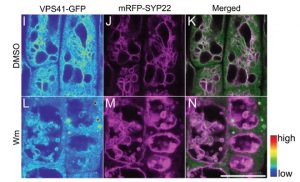
The plant vacuole makes up to 90% of the cell volume and its dynamics are important for regulating growth, development and stomatal movement. Membrane fusion between the vacuole and the smaller vesicles is at the heart of central vacuole establishment. Homotypic fusion and vacuole protein sorting (HOPS) tethering complex was previously shown to mediate vacuolar fusion in yeast and plants, but the components of HOPS are not well characterized in plants, although its importance in embryogenesis and pollen tube growth is known. Brillada et al. identified plant HOPS (VPS33 and VPS41) and examined their function in plants. Both proteins localized in the late endosomal compartments, but only VPS41 was detected at the tonoplast membrane. In contrast to yeast, the plant HOPS recruitment to liposomes is inhibited by phosphoinositides. Both VPS33 and VPS41 interacted with each other and the vacuolar SNARE SYP22 and relied on this interaction for the correct localization. Silencing of the VPS33 and VPS41 led to fragmented vacuoles, underscoring the role of HOPS in lytic vacuole fusion. (Summary by Magdalena Julkowska) Proc. Natl. Acad. Sci. USA 10.1073/pnas.1807763115
Chloroplast TOC/TIC protein translocon pore size ($)
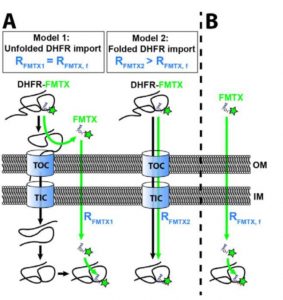 Most of the proteins that function inside of mitochondria or chloroplasts are encoded in the nucleus, translated in the cytosol, and imported through one or two membrane-localized translocons. (In mitochondria the outer- and inner-membrane translocons are called TOM and TIM, and in chloroplasts they are TOC and TIC). Mitochondrial studies indicate that proteins are translocated unfolded, and for chloroplast translocons this has been the assumption at least for larger proteins. Ganesan et al. tested this assumption using dihydrofolate reductase (DHFR) and its ligand, methotrexate (MTX), which non-covalently binds to and stabilizes folded DHFR. The authors showed that fluorescently labelled MTX is imported more rapidly and in an ATP-dependent manner in the presence of DHFR, indicating that it is carried in with the folded protein. These results indicate that the functional pore size of the chloroplast translocons is larger than previously assumed. Fixed-diameter probe studies confirmed this finding, with “critical implications regarding the mechanism and structure of the TOC/TIC translocons.” (Summary by Mary Williams) Plant Cell 10.1105/tpc.18.00427
Most of the proteins that function inside of mitochondria or chloroplasts are encoded in the nucleus, translated in the cytosol, and imported through one or two membrane-localized translocons. (In mitochondria the outer- and inner-membrane translocons are called TOM and TIM, and in chloroplasts they are TOC and TIC). Mitochondrial studies indicate that proteins are translocated unfolded, and for chloroplast translocons this has been the assumption at least for larger proteins. Ganesan et al. tested this assumption using dihydrofolate reductase (DHFR) and its ligand, methotrexate (MTX), which non-covalently binds to and stabilizes folded DHFR. The authors showed that fluorescently labelled MTX is imported more rapidly and in an ATP-dependent manner in the presence of DHFR, indicating that it is carried in with the folded protein. These results indicate that the functional pore size of the chloroplast translocons is larger than previously assumed. Fixed-diameter probe studies confirmed this finding, with “critical implications regarding the mechanism and structure of the TOC/TIC translocons.” (Summary by Mary Williams) Plant Cell 10.1105/tpc.18.00427
Evolution and diversification of the plant gibberellin receptor GID1
 Giberellins (GA) are plant hormones that have diverse role in plant growth and development. Although many GAs have been identified, only few of them show functional activity in plants. GAs are perceived by the GID1 receptor, which is widespread in vascular plants and structuraly similar to carboxylesterases (CXEs). Yoshida et al. examined the evolutionary establishment of GID1 across the vascular plants. To examine the role of conserved residues, null gid1-4 mutants in rice that have severe growth defects were complemented with GID1 versions in which conserved amino acids interacting with biologically active GA4 were substituted by alanine. The residues responsible for recognition of the C6-COOH group, non-polar interactions, and adjustment of the lid structure that interacts with DELLA proteins, were prerequisite for GID1 functionality. Interestingly, GID1 is encoded by one gene in the majority of monocots, whereas most dicot species have two types of GID1, A and B. GID1 B-type appears to be under purifying selection targeting the loop region, suggesting neofunctionalization. The B-type GID1s are not only hypersensitive to active GA, but also predominantly expressed in roots in most of the species studied. Those results suggest that hypersentive B-type GID allows for root growth, which is more responsive to GA than the shoot, providing an evolutionary advantage in adverse environmental conditions. (Summary by Magdalena Julkowska) Proc. Natl. Acad. Sci. USA 10.1073/pnas.1806040115
Giberellins (GA) are plant hormones that have diverse role in plant growth and development. Although many GAs have been identified, only few of them show functional activity in plants. GAs are perceived by the GID1 receptor, which is widespread in vascular plants and structuraly similar to carboxylesterases (CXEs). Yoshida et al. examined the evolutionary establishment of GID1 across the vascular plants. To examine the role of conserved residues, null gid1-4 mutants in rice that have severe growth defects were complemented with GID1 versions in which conserved amino acids interacting with biologically active GA4 were substituted by alanine. The residues responsible for recognition of the C6-COOH group, non-polar interactions, and adjustment of the lid structure that interacts with DELLA proteins, were prerequisite for GID1 functionality. Interestingly, GID1 is encoded by one gene in the majority of monocots, whereas most dicot species have two types of GID1, A and B. GID1 B-type appears to be under purifying selection targeting the loop region, suggesting neofunctionalization. The B-type GID1s are not only hypersensitive to active GA, but also predominantly expressed in roots in most of the species studied. Those results suggest that hypersentive B-type GID allows for root growth, which is more responsive to GA than the shoot, providing an evolutionary advantage in adverse environmental conditions. (Summary by Magdalena Julkowska) Proc. Natl. Acad. Sci. USA 10.1073/pnas.1806040115
CLAVATA allowed 3D growth in land plants
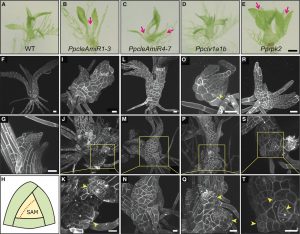 Land plants had to acquire new ways to occupy the terrestrial environment, including the innovative shooting system with organs in a radial position. This new 3D form of growth was possible thanks to the capacity to rotate stem cells divisions through different orientation planes. In Arabidopsis the CLAVATA (CLV) and WUSCHEL (WUS) pathways regulate stem cell proliferation including cell fate, proliferation and growth. Whitewoods and co-workers searched for homologs of genes from the CLV pathway in green algae and land plants, finding only homologs of CLV3-like (CLE) and CLV1/BAM in early diverging bryophytes and all other land plants. Expression analysis of the homologs found in Physcomitrella showed that they were expressed during the 3D growth phase, and furthermore RNAi mutants of the genes had a defective 2D-3D growth transition. (Summary by Cecilia Vasquez-Robinet) Curr. Biol. 10.1016/j.cub.2018.05.068
Land plants had to acquire new ways to occupy the terrestrial environment, including the innovative shooting system with organs in a radial position. This new 3D form of growth was possible thanks to the capacity to rotate stem cells divisions through different orientation planes. In Arabidopsis the CLAVATA (CLV) and WUSCHEL (WUS) pathways regulate stem cell proliferation including cell fate, proliferation and growth. Whitewoods and co-workers searched for homologs of genes from the CLV pathway in green algae and land plants, finding only homologs of CLV3-like (CLE) and CLV1/BAM in early diverging bryophytes and all other land plants. Expression analysis of the homologs found in Physcomitrella showed that they were expressed during the 3D growth phase, and furthermore RNAi mutants of the genes had a defective 2D-3D growth transition. (Summary by Cecilia Vasquez-Robinet) Curr. Biol. 10.1016/j.cub.2018.05.068
Plant iron acquisition strategy exploited by an insect herbivore ($)
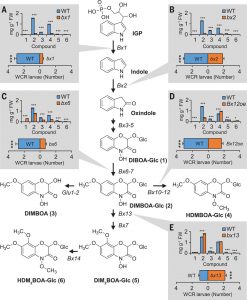 When it comes to evading pests and pathogens, stealth comes in handy. Anything that advertises “food here” is an invitation. Therefore, the work of Hu et al. shouldn’t be surprising, but it is a great story. Phytosiderophores such as benzoxazinoid are secreted by roots to chelate iron and facilitate its uptake. Hu et al. found that the benzoxazinoid/ iron complex attracts the western corn rootworm (WCR) herbivore of maize to maize roots. Furthermore, the herbivore benefits from iron assimilated via the benzoxazinoid/iron complex, and a breakdown compound derived from benzoxazinoid confers protection for the herbivore against a pathogenic nematode pest. As the authors observe, “The diverse costs and benefits of the benzoxazinoid pathway for maize represent an optimization problem for plant breeding that may have contributed to the persistence of WCR as a damaging maize pest.” (Summary by Mary Williams) Science 10.1126/science.aat4082
When it comes to evading pests and pathogens, stealth comes in handy. Anything that advertises “food here” is an invitation. Therefore, the work of Hu et al. shouldn’t be surprising, but it is a great story. Phytosiderophores such as benzoxazinoid are secreted by roots to chelate iron and facilitate its uptake. Hu et al. found that the benzoxazinoid/ iron complex attracts the western corn rootworm (WCR) herbivore of maize to maize roots. Furthermore, the herbivore benefits from iron assimilated via the benzoxazinoid/iron complex, and a breakdown compound derived from benzoxazinoid confers protection for the herbivore against a pathogenic nematode pest. As the authors observe, “The diverse costs and benefits of the benzoxazinoid pathway for maize represent an optimization problem for plant breeding that may have contributed to the persistence of WCR as a damaging maize pest.” (Summary by Mary Williams) Science 10.1126/science.aat4082
Stepwise and independent origins of roots among land plants
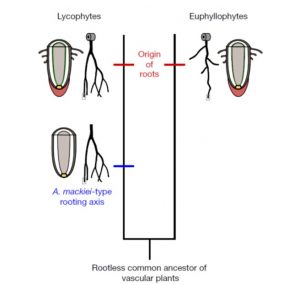 The Rhynie chert (near the village of Rhynie, Scotland; chert is a type of sedimentary rock) is an important site for plant biologists as it holds some of earliest and best preserved land-plant fossils. Hetherington and Dolan examined more than 600 thin sections prepared from this site, specifically looking for fossil evidence of early roots. They focused on Asteroxylon mackiei, an abundant but now extinct early vascular plant. Altogether they found five samples that contained A. mackiei root tips. Strikingly, each of these samples showed a root meristem but not a root cap, indicating that the roots of these extinct plants were covered solely with a sheet of epidermal tissue. These findings suggest two things: that lycophyte roots evolved in two stages, and that the roots of lycophytes and euphyllophytes have independent origins and represent an example of convergent evolution. (Summary by Mary Williams) Nature 10.1038/s41586-018-0445-z
The Rhynie chert (near the village of Rhynie, Scotland; chert is a type of sedimentary rock) is an important site for plant biologists as it holds some of earliest and best preserved land-plant fossils. Hetherington and Dolan examined more than 600 thin sections prepared from this site, specifically looking for fossil evidence of early roots. They focused on Asteroxylon mackiei, an abundant but now extinct early vascular plant. Altogether they found five samples that contained A. mackiei root tips. Strikingly, each of these samples showed a root meristem but not a root cap, indicating that the roots of these extinct plants were covered solely with a sheet of epidermal tissue. These findings suggest two things: that lycophyte roots evolved in two stages, and that the roots of lycophytes and euphyllophytes have independent origins and represent an example of convergent evolution. (Summary by Mary Williams) Nature 10.1038/s41586-018-0445-z
Mentoring lessons from plants
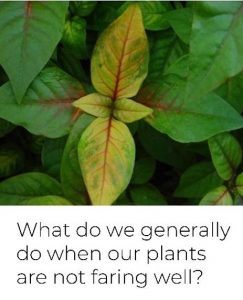 Everybody mentors, but usually without much training in how to be an effective mentor. I recommend that you have a look at Beronda Montgomery’s short article, “From Deficits to Possibilities: Mentoring Lessons from Plants on Cultivating Individual Growth through Environmental Assessment and Optimization.” The article makes the simple but effective suggestion that most of us go about mentoring all wrong, assuming that our mentees’ failures are due to their own deficiencies. Instead, Montgomery suggests that instead we look at environmental and cultural factors that contribute to their inability to thrive, like we do with plants. She also observes that when the plants under our care fare poorly, we wonder what we as caretakers are doing wrong; shouldn’t we afford our students and mentees the same consideration, rather than blaming them? She pulls these views together into a series of six lessons from plants and their mentoring implications. I think this short paper would be a great journal club option, as the simple change in perspective about the relationships between mentors and mentees is likely to have far-reaching benefits to those in our community. (Summary by Mary Williams) Public Philosophy J. 6-15-173284
Everybody mentors, but usually without much training in how to be an effective mentor. I recommend that you have a look at Beronda Montgomery’s short article, “From Deficits to Possibilities: Mentoring Lessons from Plants on Cultivating Individual Growth through Environmental Assessment and Optimization.” The article makes the simple but effective suggestion that most of us go about mentoring all wrong, assuming that our mentees’ failures are due to their own deficiencies. Instead, Montgomery suggests that instead we look at environmental and cultural factors that contribute to their inability to thrive, like we do with plants. She also observes that when the plants under our care fare poorly, we wonder what we as caretakers are doing wrong; shouldn’t we afford our students and mentees the same consideration, rather than blaming them? She pulls these views together into a series of six lessons from plants and their mentoring implications. I think this short paper would be a great journal club option, as the simple change in perspective about the relationships between mentors and mentees is likely to have far-reaching benefits to those in our community. (Summary by Mary Williams) Public Philosophy J. 6-15-173284



